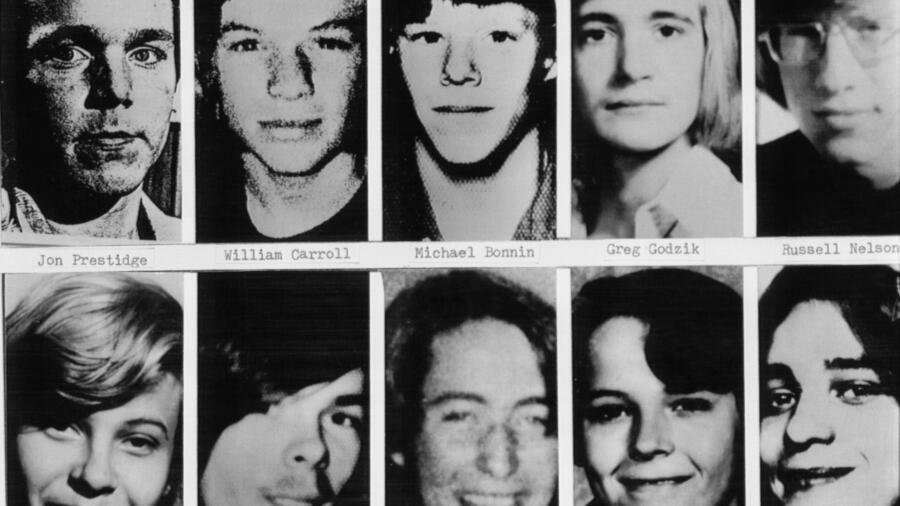They were sons. Brothers. Students. Dreamers.
Before John Wayne Gacy became known as the “Killer Clown,” before the nation was haunted by headlines and horror stories, there were 33 young men who simply wanted to live. Their names were nearly eclipsed by the man who murdered them, but today, we remember them not for how they died—but for how they lived.
This is their story.
The First Known Victim: Timothy “Jack” McCoy
Sixteen-year-old Jack McCoy left his relatives’ home in Michigan after Christmas 1971, promising to call when he got back to Iowa.
He never did.
It would take 14 long years before his identity was confirmed, his remains discovered beneath the floorboards of a suburban Chicago house that had become a tomb. Jack was Gacy’s first known victim—the first light extinguished in what would become a dark and unrelenting spree.
Boys Enter the House—But Never Leave
In Boys Enter the House, journalist David Nelson pieced together the victims’ stories through interviews with their families and friends. Instead of spotlighting Gacy’s monstrous acts, Nelson turned the narrative toward the lives stolen—restoring humanity to those who were reduced to crime scene photos and dental records.
Walking the same streets the boys once did in Chicago’s Uptown, Nelson uncovered a trail of love, pain, and forgotten potential.
“Everyone talks about the killer,” he wrote. “But no one talks about the boys.”
The Community Scarred, The Families Shattered
Gacy didn’t need to stalk strangers. His charm and community standing opened doors. He offered construction jobs to desperate teens. He smiled at parents, shook hands with neighbors, and hid his horror behind a handshake.
Many of his victims were vulnerable—runaways, LGBTQ youth, or boys from abusive homes. Their disappearances were often shrugged off, brushed aside with chilling indifference by law enforcement.
They didn’t vanish without a trace. They vanished without being heard.
The Names Behind the Numbers
These were not faceless statistics. They were vibrant, complex young men. Here are just a few of their stories:
- John Mowery – A 19-year-old with dreams of electrical work, tragically murdered just years after his sister was also taken by violence.
- Randy Reffett – Only 15, from a family that had already endured brutal domestic abuse. His brother Clyde later said he believes he narrowly escaped the same fate.
- Billy Carroll – Disappeared the night of his brother’s birthday in 1976. His family never celebrated that day again. Years later, his younger brother would also be killed, and his father would die heartbroken.
- Toni Carmichael, William Kindred, and many others—each name etched into the record of a tragedy that should never have happened.
These boys weren’t broken. They were survivors of poverty, neglect, and sometimes even trauma—until they couldn’t survive one man’s cruelty.
“There Was Something Off About Him”
Mary Jo Paulus, girlfriend of Billy Kindred, remembered seeing Gacy at a bar in 1978. She couldn’t explain it, but something felt wrong. And she wasn’t alone.
Clyde Reffett, Randy’s brother, turned down a ride from Gacy—a choice that likely saved his life. Decades later, he still shudders at the memory.
Gacy moved through the city like a predator cloaked in charm. His ability to blend in, to seem normal, was part of what made him so dangerous.
A Justice That Came Too Late
When authorities finally searched Gacy’s home in December 1978, they found 29 bodies in his crawl space. Four others were recovered from nearby rivers. The gruesome discovery made national news—but it also exposed a systemic failure: Gacy had been previously convicted of sexually assaulting a teenage boy in 1968 and sentenced to 10 years in prison. He served less than two.
By the time he was executed in 1994, 33 lives were already lost. Some families felt a grim relief. Others called it an ending that came too little, too late.
The Legacy of Loss
For the families left behind, healing was not a destination—it was a process that many are still navigating.
Some fell into addiction. Others became advocates for victim rights. A few refused to speak Gacy’s name, choosing instead to honor the boy they lost.
“I think about him every day,” one mother told reporters. “He had a smile that could light up a room.”
That smile lives on in photo albums, in faded yearbooks, in memories passed from one sibling to another. Because these boys were not born to die in horror—they were born to live in hope.
We Remember Them
The names of Gacy’s victims are now engraved on memorials. But the real remembrance happens when we tell their stories, share their dreams, and refuse to let their memories be overshadowed by the man who took their lives.
💔 Victims Identified (Partial List):
| Name | Age | Year Disappeared |
|---|---|---|
| Timothy McCoy | 16 | 1972 |
| Randy Reffett | 15 | 1976 |
| William Kindred | 19 | 1978 |
| John Mowery | 19 | 1977 |
| Billy Carroll | 16 | 1976 |
| Michael Marino | 14 | 1976 |
| Robert Gilroy | 18 | 1977 |
| Russell Nelson | 21 | 1977 |
| Timothy O’Rourke | 20 | 1978 |
To this day, several victims remain unidentified.
Final Thoughts: They Were Loved. They Matter.
John Wayne Gacy may have stolen their futures, but he could never erase their pasts. As long as we say their names and share their stories, they will never truly be gone.
They were more than Gacy’s victims.
They were human beings, full of laughter, light, and promise.

